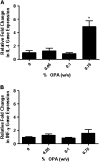Irritancy and allergic responses induced by topical application of ortho-phthalaldehyde
- PMID: 20176622
- PMCID: PMC2871752
- DOI: 10.1093/toxsci/kfq054
Irritancy and allergic responses induced by topical application of ortho-phthalaldehyde
Abstract
Although ortho-phthalaldehyde (OPA) has been suggested as an alternative to glutaraldehyde for the sterilization and disinfection of hospital equipment, the toxicity has not been thoroughly investigated. The purpose of these studies was to evaluate the irritancy and sensitization potential of OPA. The EpiDerm Skin Irritation Test was used to evaluate in vitro irritancy potential of OPA and glutaraldehyde. Treatment with 0.4125 and 0.55% OPA induced irritation, while glutaraldehyde exposure at these concentrations did not. Consistent with the in vitro results, OPA induced irritancy, evaluated by ear swelling, when mice were treated with 0.75%. Initial evaluation of the sensitization potential was conducted using the local lymph node assay at concentrations ranging from 0.005 to 0.75%. A concentration-dependent increase in lymphocyte proliferation was observed with a calculated EC3 value of 0.051% compared to that of 0.089%, previously determined for glutaraldehyde. Immunoglobulin (Ig) E-inducing potential was evaluated by phenotypic analysis of draining lymph node (DLN) cells and measurement of total and specific serum IgE levels. The 0.1 and 0.75% exposed groups yielded significant increases in the IgE+B220+ cell population in the lymph nodes while the 0.75% treated group demonstrated significant increases in total IgE, OPA-specific IgE, and OPA-specific IgG(1). In addition, significant increases in interleukin-4 messenger RNA and protein expression in the DLNs were observed in OPA-treated groups. The results demonstrate the dermal irritancy and allergic potential of OPA and raise concern about the proposed/intended use of OPA as a safe alternative to glutaraldehyde.
Figures







Similar articles
-
Intralaboratory validation of alternative endpoints in the murine local lymph node assay for the identification of contact allergic potential: primary ear skin irritation and ear-draining lymph node hyperplasia induced by topical chemicals.Arch Toxicol. 2001 Feb;74(12):733-44. doi: 10.1007/s002040000192. Arch Toxicol. 2001. PMID: 11305775
-
Use of a B cell marker (B220) to discriminate between allergens and irritants in the local lymph node assay.Toxicol Sci. 2002 Aug;68(2):420-8. doi: 10.1093/toxsci/68.2.420. Toxicol Sci. 2002. PMID: 12151637
-
Prior Exposure to Ortho-Phthalaldehyde Augments IgE-Mediated Immune Responses to Didecyldimethylammonium Chloride: Potential for 2 Commonly Used Antimicrobials to Synergistically Enhance Allergic Disease.Toxicol Sci. 2020 Nov 1;178(1):127-137. doi: 10.1093/toxsci/kfaa112. Toxicol Sci. 2020. PMID: 32647894 Free PMC article.
-
The local lymph node assay and potential application to the identification of drug allergens.Toxicology. 2001 Feb 2;158(1-2):59-64. doi: 10.1016/s0300-483x(00)00408-x. Toxicology. 2001. PMID: 11164993 Review.
-
Local lymph node assay (LLNA) for detection of sensitization capacity of chemicals.Methods. 2007 Jan;41(1):54-60. doi: 10.1016/j.ymeth.2006.07.006. Methods. 2007. PMID: 16938465 Review.
Cited by
-
Potential classification of chemical immunologic response based on gene expression profiles.J Immunotoxicol. 2020 Dec;17(1):122-134. doi: 10.1080/1547691X.2020.1758855. J Immunotoxicol. 2020. PMID: 32449871 Free PMC article.
-
Potential health effects associated with dermal exposure to occupational chemicals.Environ Health Insights. 2014 Dec 17;8(Suppl 1):51-62. doi: 10.4137/EHI.S15258. eCollection 2014. Environ Health Insights. 2014. PMID: 25574139 Free PMC article. Review.
-
The role of lymphocyte proliferation tests in assessing occupational sensitization and disease.Curr Opin Allergy Clin Immunol. 2012 Apr;12(2):102-10. doi: 10.1097/ACI.0b013e3283511396. Curr Opin Allergy Clin Immunol. 2012. PMID: 22306552 Free PMC article. Review.
-
Prevalence of work-related skin symptoms and associated factors among tertiary hospital workers exposed to cleaning agents in Southern Africa.Contact Dermatitis. 2023 Sep;89(3):178-189. doi: 10.1111/cod.14374. Epub 2023 Jul 3. Contact Dermatitis. 2023. PMID: 37401107 Free PMC article.
-
Potential Inhibitory Influence of miRNA 210 on Regulatory T Cells during Epicutaneous Chemical Sensitization.Genes (Basel). 2016 Dec 27;8(1):9. doi: 10.3390/genes8010009. Genes (Basel). 2016. PMID: 28035981 Free PMC article.
References
-
- Azadi S, Klink KJ, Meade BJ. Divergent immunological responses following glutaraldehyde exposure. Toxicol. Appl. Pharmacol. 2004;197:1–8. - PubMed
-
- Basketter DA, Lea LJ, Dickens A, Briggs D, Pate I, Dearman RJ, Kimber I. A comparison of statistical approaches to the derivation of EC3 values from local lymph node assay dose responses. J. Appl. Toxicol. 1999;19:261–266. - PubMed
-
- Butler JE. Enzyme-linked immunosorbent assay. J. Immunoassay. 2000;21:165–209. - PubMed
-
- ChemicalLand 21. (Undated). o-Phthaladehyde. Available at: http://www.chemicalland21.com/specialtychem/perchem/o-PHTHALALDEHYDE.htm. Accessed August 19, 2009.
-
- Franchi A, Franco G. Evidence-based decision making in an endoscopy nurse with respiratory symptoms exposed to the new ortho-phthalaldehyde (OPA) disinfectant. Occup. Med. (Lond) 2005;55:575–578. - PubMed
Publication types
MeSH terms
Substances
Grants and funding
LinkOut - more resources
Full Text Sources
Research Materials

